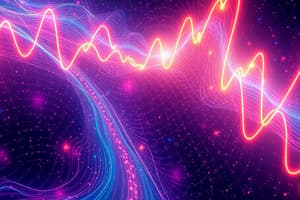Podcast
Questions and Answers
What is the approximate time of occurrence of P1 response in adults with normal hearing?
What is the approximate time of occurrence of P1 response in adults with normal hearing?
- 20 msec after stimulus onset
- 100 msec after stimulus onset
- 200 msec after stimulus onset
- 50 msec after stimulus onset (correct)
Which of the following is NOT a generator of P1 response?
Which of the following is NOT a generator of P1 response?
- Hippocampus
- Planum temporale
- Primary auditory cortex (Heschl’s gyrus)
- Visual cortex (correct)
What is the primary factor that determines the amplitudes and latencies of sensory-evoked potentials?
What is the primary factor that determines the amplitudes and latencies of sensory-evoked potentials?
- Endogenous factors, such as the psychological significance of a stimulus
- Patient age and state
- Physical and temporal characteristics of the stimulus, such as intensity or frequency (correct)
- Recording location and technique
What is the time range for the N2 component of the late latency response?
What is the time range for the N2 component of the late latency response?
What is the N1 component often described as?
What is the N1 component often described as?
What is the direction of the dipoles located in/near the auditory cortex that generate the N1b component?
What is the direction of the dipoles located in/near the auditory cortex that generate the N1b component?
Who first described the P1-N1-P2 complex in response to sound?
Who first described the P1-N1-P2 complex in response to sound?
What is the origin of late latency potentials?
What is the origin of late latency potentials?
What is the name of the response that signals the neural encoding of sound onset at the level of the auditory cortex?
What is the name of the response that signals the neural encoding of sound onset at the level of the auditory cortex?
What is the significance of the P1-N1-P2 complex for audiologists and hearing scientists?
What is the significance of the P1-N1-P2 complex for audiologists and hearing scientists?
Flashcards are hidden until you start studying
Study Notes
Auditory Late Latency Potential
- Late latency potentials (>80ms) in AEPs are cortical in origin, and are larger and lower in frequency than early and middle-latency potentials.
- They are highly dependent on stimulus type, recording location, recording technique, patient age, and state.
The Auditory P1-N1-P2 Complex
- Discovered in 1939 by P.A.Davis, who described changes in EEG in response to sound.
- Not specific to the auditory modality, as similar responses with different cortical sources are seen with visual or somatosensory stimulation.
- Provides information regarding the arrival of sound information to the auditory cortex.
Components of Late Latency Responses
- Four components:
- P1: occurs between 55 and 80 ms
- N1: occurs between 90 and 110 ms
- P2: occurs between 145 and 180 ms
- N2: occurs between 180 and 250 ms
P1 Component
- First vertex positive peak of the P1-N1-P2 complex
- Typically occurs approximately 50 msec after stimulus onset in adults with normal hearing
- Thought to represent late thalamic projections into the early auditory cortex and is part of the specific sensory system
- Strongly related to stimulus parameters
- Generators:
- Primary auditory cortex (Heschl’s gyrus)
- Hippocampus
- Planum temporale
- Lateral temporal regions
- Possibly subcortical regions
N1 Component
- Prominent negative deflection in the auditory event-related potential (ERP)
- Primarily an exogenous potential, occurring at about 100 ms after the onset of an auditory stimulus
- Associated with the activity of the non-specific polysensory system within the contralateral supratemporal auditory cortex
- Often described as an “onset” response, signaling the neural encoding of sound onset at the level of the auditory cortex
- Generators:
- Multiple generators in the primary and secondary auditory cortex include 3 underlying components:
- Frontocentral negativity: N1b of first component N1
- Multiple generators in the primary and secondary auditory cortex include 3 underlying components:
Studying That Suits You
Use AI to generate personalized quizzes and flashcards to suit your learning preferences.




